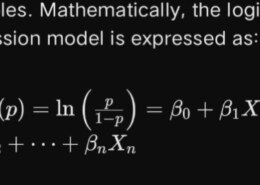Logistic regression is a statistical method used for binary classification problems, where the outcome is one of two possible categories. It models the relationship between a dependent binary variable and one or more independent variables by estimating probabilities using a logistic (sigmoid) functiRead more
Logistic regression is a statistical method used for binary classification problems, where the outcome is one of two possible categories. It models the relationship between a dependent binary variable and one or more independent variables by estimating probabilities using a logistic (sigmoid) function. The output is a probability value that is mapped to one of the two possible classes using a threshold, typically 0.5.
In logistic regression, the model predicts the log-odds of the dependent variable being in a particular category. The log-odds are a linear combination of the independent variables.
Where:
– \( p \) is the probability of the dependent variable being 1.
– \( \beta_0 \) is the intercept.
– \( \beta_1, \beta_2, \ldots, \beta_n \) are the coefficients of the independent variables \( X_1, X_2, \ldots, X_n \).
Logistic regression is widely used in fields such as medicine, finance, and social sciences for tasks like disease prediction, credit scoring, and survey analysis.
See less

In a multi-process operating system, the resource allocation algorithm is known as the Banker's Algorithm. It is utilized to manage resource allocation. It's used to make sure that a group of programs on a single computer can share the resources they have (like CPU time, memory, I/O devices, etc.).Read more
In a multi-process operating system, the resource allocation algorithm is known as the Banker’s Algorithm. It is utilized to manage resource allocation. It’s used to make sure that a group of programs on a single computer can share the resources they have (like CPU time, memory, I/O devices, etc.). fairly and effectively.
The Investor’s Calculation works by reproducing a ledger for each interaction, where the assets distributed to the cycle are treated as stores into the record. The process’s “funds,” or resources, are checked by the algorithm to see if they are sufficient to allocate the requested resources. In the event that it does, the allocation is carried out, and the process’s account is updated in line with this. The allocation is stopped until sufficient resources are available.
The algorithm ensures that no process can acquire more resources than it has been allocated and that no process can exceed its resources. This ensures that processes can run safely and effectively while also preventing deadlocks.
See less